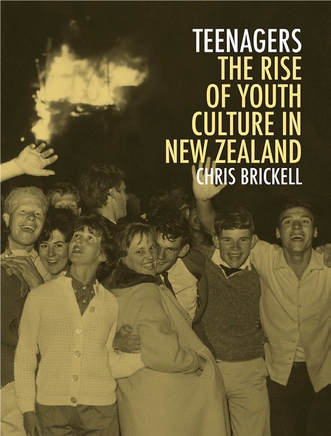11/6/2017

Teenagers: The Rise of Youth Culture in New Zealand
by Chris Brickell
‘History teaches us that young people pull out and re-stitch the threads of the past.’
So writes Chris Brickell nearing the conclusion of his book, Teenagers: The Rise of Youth Culture in New Zealand.
The Author takes us on a chronological journey through aspects of teenage years from the 1860s to recent times. Following the introduction, the book has five chapters the first of which deals with early immigrants and their interaction with Maori as ships brought new migrants into New Zealand ports, the boys often becoming itinerant and girls dependent on domestic service.
Chapter two describes the growth of industry and establishment of small cities. After that, follows the consolidation of youth culture and the differences between town and country dwellers.
The fourth chapter introduces American influence on New Zealand youngsters following the Great Depression and the Second World War as young folk were more able to avoid adult surveillance. Chapter five brings a view of the dynamism of the 1950s and 1960s as teenagers endured a new level of scrutiny by media. Some reference is made to homosexuality, and its consequences for young folk, at intervals throughout the book.
With the help of many diaries and photographs there emerges a description of youth employment from the days of domestic service to World War II, after which few teenagers wanted to work as domestic servants. War had increased girls’ and boys’ independence, helped along by improved mobility facilitated by railways and trams, not to mention motor bikes. The ebb and flow of Maori/Pakeha relationships is discussed.
Having lived through some of the period it was pleasurable to be reminded of past cultural happenings, whereas certain other aspects of the time must have flown beneath my radar and reading about them now has been enlightening. Students of this subject would find it interesting and informative while other readers could gain an insight into this facet of our history.
The book is an historical account up to and only touching on evolving present day culture, making few predictions about future developments and the positive and negative impacts of future technology and drug culture.
Included in the volume is a list of abbreviations used, 18 pages of notes, a list of illustration credits, a bibliography and an index. The book is a beautiful production and its binding and cover make it a pleasure to handle.
I find this to be a magnificent portrayal of the rise of New Zealand youth culture. The author is to be congratulated on a comprehensively researched, and enjoyable, work.
by Chris Brickell
‘History teaches us that young people pull out and re-stitch the threads of the past.’
So writes Chris Brickell nearing the conclusion of his book, Teenagers: The Rise of Youth Culture in New Zealand.
The Author takes us on a chronological journey through aspects of teenage years from the 1860s to recent times. Following the introduction, the book has five chapters the first of which deals with early immigrants and their interaction with Maori as ships brought new migrants into New Zealand ports, the boys often becoming itinerant and girls dependent on domestic service.
Chapter two describes the growth of industry and establishment of small cities. After that, follows the consolidation of youth culture and the differences between town and country dwellers.
The fourth chapter introduces American influence on New Zealand youngsters following the Great Depression and the Second World War as young folk were more able to avoid adult surveillance. Chapter five brings a view of the dynamism of the 1950s and 1960s as teenagers endured a new level of scrutiny by media. Some reference is made to homosexuality, and its consequences for young folk, at intervals throughout the book.
With the help of many diaries and photographs there emerges a description of youth employment from the days of domestic service to World War II, after which few teenagers wanted to work as domestic servants. War had increased girls’ and boys’ independence, helped along by improved mobility facilitated by railways and trams, not to mention motor bikes. The ebb and flow of Maori/Pakeha relationships is discussed.
Having lived through some of the period it was pleasurable to be reminded of past cultural happenings, whereas certain other aspects of the time must have flown beneath my radar and reading about them now has been enlightening. Students of this subject would find it interesting and informative while other readers could gain an insight into this facet of our history.
The book is an historical account up to and only touching on evolving present day culture, making few predictions about future developments and the positive and negative impacts of future technology and drug culture.
Included in the volume is a list of abbreviations used, 18 pages of notes, a list of illustration credits, a bibliography and an index. The book is a beautiful production and its binding and cover make it a pleasure to handle.
I find this to be a magnificent portrayal of the rise of New Zealand youth culture. The author is to be congratulated on a comprehensively researched, and enjoyable, work.
Flaxflower Review by Irene Thomas
Title: Teenagers: The Rise of Youth Culture in New Zealand
Author: Chris Brickell
Publisher: Auckland University Press
ISBN: 9781869408688
RRP: $49.99
Available: bookshops
Author: Chris Brickell
Publisher: Auckland University Press
ISBN: 9781869408688
RRP: $49.99
Available: bookshops
No comments:
Post a Comment